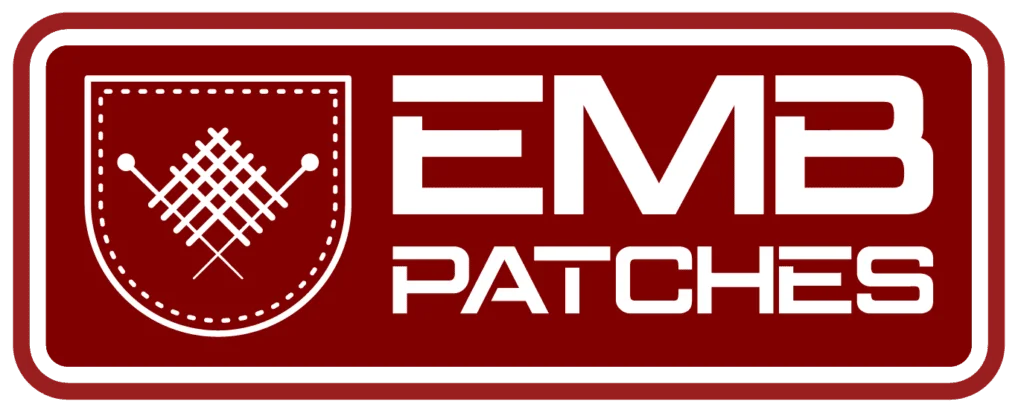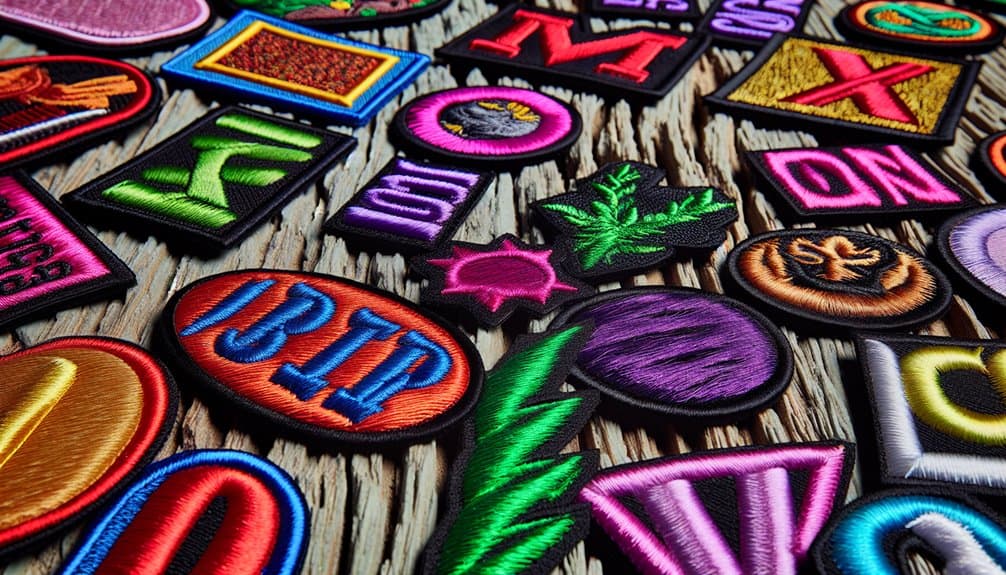Select appropriate backing materials based on your application needs when creating customized embroidered patches. Consider thread count, as higher counts allow for more intricate details. Size constraints affect design complexity; text should be at least 4mm tall for legibility. Choose embroidery-friendly colors, limiting your palette to 5-7 core options. Include professional borders between 2-4mm wide. Balance text and graphics, allocating approximately 70% to visuals. Plan attachment methods early to avoid design complications later. These fundamental principles form the foundation for successful patch creation.
Choose the Right Backing Material for Your Application
The foundation of any quality embroidered patch lies in selecting the appropriate backing material. Different backing types serve distinct purposes, and understanding their application suitability is crucial for creating durable, functional designs.
Heat-seal backings work well for permanent attachment to fabrics that can withstand high temperatures, while velcro backings offer removable options ideal for tactical gear or frequently changed displays.
For delicate fabrics, plastic backings provide stability without adding excessive weight, and traditional merrow borders with sew-on backing deliver the most secure attachment for heavily used items like work uniforms.
Consider the environment where your patch will be used—outdoor applications require water-resistant materials, while patches for children’s items should prioritize non-irritating backings.
The right choice guarantees your custom design maintains its integrity throughout its intended use.
Understand Thread Count and Its Impact on Detail
When examining the technical aspects of embroidered patches, thread count emerges as a critical factor determining the final appearance and quality of your design. Higher thread counts allow for more intricate details, while lower counts create bolder, simpler images. Understanding this relationship helps achieve desired outcomes when personalizing patches.
| Thread Count | Detail Level | Recommended Applications |
|---|---|---|
| 30-40 stitches/cm² | Low | Large logos, block letters |
| 45-55 stitches/cm² | Medium | Standard designs, text |
| 60+ stitches/cm² | High | Fine details, gradients |
Different thread types also influence detail capabilities. Polyester threads offer vibrant colors for detailed work, while rayon provides a distinctive sheen. Advanced techniques like satin stitches create smooth surfaces, while fill stitches provide texture. Remember that intricate designs require higher thread counts to render fine elements properly.
Consider Size Constraints When Designing Complex Images
Designing a complex image for embroidered patches requires careful attention to size constraints, as smaller dimensions drastically reduce the level of detail that can be effectively reproduced.
Text elements must maintain a minimum height of approximately 4mm (or 0.16 inches) to guarantee legibility after embroidery, with simpler fonts generally performing better at reduced sizes.
As patch dimensions decrease, designers must also reduce pattern density, eliminating intricate details that would otherwise cause thread crowding, leading to a muddled appearance in the final product.
Scaling Affects Detail Level
Scale presents one of the most critical challenges in embroidery patch design, directly impacting the level of detail possible in the final product. Fine elements can become lost or distorted when artwork is reduced from its original size to fit a small patch. Proper scaling techniques guarantee that important details remain visible and recognizable after production.
A design that looks impressive at four inches may become an indecipherable blur at two inches. Designers must evaluate which elements are essential and which can be simplified or removed.
Detail preservation becomes particularly challenging with text—letters smaller than 1/4 inch often blend together during stitching. Customers should understand that requesting complex designs on small patches may result in disappointment, as thread has physical limitations that digital images do not.
Scaling appropriately prevents wasted materials and guarantees customer satisfaction.
Text Legibility Requirements
Although artistic ambition often drives designers to create intricate text elements, embroidered patches impose strict legibility requirements that cannot be ignored. Text smaller than 1/4 inch in height becomes difficult to embroider clearly, resulting in blurred letters and illegible words.
Font choice greatly impacts readability factors, with serif and decorative fonts requiring larger sizes than clean sans-serif options.
When planning text for patches, designers must consider how thread thickness affects letter formation. Each character needs sufficient space for proper stitching, especially with lowercase letters featuring small details.
Bold fonts typically reproduce better than thin ones, maintaining clarity even after repeated washing and wear. For ideal results, text should be kept simple, sized appropriately, and positioned with adequate spacing between letters and words to prevent thread crowding.
Pattern Density Limitations
Three critical factors limit the complexity of embroidered patch designs: size, stitch density, and thread thickness. When patches become smaller, intricate designs may blur or distort due to the physical constraints of embroidery equipment. Advanced pattern selection techniques must adjust for dimensional limitations.
Texture impact analysis reveals that overlapping stitches in dense areas can create stiffness and unwanted bulging. This effect becomes problematic when designs exceed 1,200 stitches per square inch, potentially causing thread breakage during production and wear.
Smaller patches (under 2 inches) should utilize simpler imagery with fewer color shifts. Designers must carefully balance detail against practical limitations. Each design element requires physical space for proper stitch formation—attempting to include too many elements will compromise both visual clarity and structural integrity of the finished patch.
Select a Color Palette That Works in Embroidery
Embroidery machines work with a limited selection of thread colors compared to digital design programs, requiring careful planning to achieve visual impact.
Designers must consider how certain thread colors will appear when stitched together, as physical embroidery cannot perfectly blend shades the way digital designs can.
Professional embroiderers often recommend selecting 5-7 core colors for patch designs, as this balance provides enough variety for detail while avoiding complications that arise when attempting to incorporate too many different thread colors.
Thread Color Limitations
Unlike digital design, custom embroidered patches face notable color limitations that designers must understand before finalizing their concepts. Thread color selection must consider both aesthetic appeal and technical feasibility, as embroidery machines cannot blend colors like digital printers. Color contrast considerations become essential when working with small designs or intricate details.
| Thread Type | Available Colors | Minimum Size | Gradient Capability | Best Applications |
|---|---|---|---|---|
| Rayon | 300-400 | 1mm | Limited | Smooth designs |
| Polyester | 200-300 | 1.5mm | Poor | Outdoor use |
| Metallic | 15-20 | 2mm | None | Accents only |
| Cotton | 30-40 | 2mm | None | Textured look |
| Wool | 10-15 | 3mm | None | Vintage style |
Most manufacturers offer between 200-400 standard thread colors, considerably fewer than digital color options. This limitation requires strategic planning to maintain design integrity.
Thread Blending Effects
Color selection becomes particularly challenging when designers attempt to create blending effects in embroidered patches. Unlike digital designs, thread blending requires physical threads to create smooth color gradients, which imposes significant technical constraints.
Embroidery machines cannot seamlessly mix colors like graphic software, resulting in more abrupt shifts. Designers should select threads with intermediate shades rather than expecting true blending when planning color gradients. The physical limitations of embroidery mean that subtle gradients work better than dramatic color shifts.
Thread blending works most effectively when moving between closely related hues, such as light blue to medium blue, rather than contrasting colors like yellow to purple. Sampling thread combinations before finalizing a design helps identify potential issues and guarantees the final patch achieves the desired visual effect without disappointment.
Incorporate Borders for Professional Finishing
A well-designed border can transform an ordinary embroidered patch into a professional, finished product that stands out with distinction.
When selecting border styles, creators should consider how the edging complements the central design rather than competing with it. Classic merrowed edges provide durability while satin stitch borders offer a smooth, elegant appearance that enhances design cohesion.
Border width matters greatly—too thin and it may unravel over time; too thick and it might overwhelm delicate interior elements. Most professional patches utilize borders between 2-4mm in width, striking an ideal balance between protection and aesthetics.
Color selection is equally important. Contrasting borders highlight the patch, while complementary colors create a more unified appearance.
Remember that borders serve both decorative and functional purposes. They prevent fraying while providing a clean visual framework for your embroidered creation.
Balance Text and Graphics for Maximum Impact
Many successful embroidered patches achieve their impact through a strategic balance between textual elements and graphic imagery. When designing a patch, careful text placement guarantees legibility while complementing visual components. Overcrowding with words can diminish visual appeal, while too little text might fail to convey essential information.
Graphic harmony requires thoughtful consideration of proportions. Designers should allocate approximately 70% of space to dominant visual elements when incorporating both text and graphics. This balance creates focal points that draw attention while maintaining readability.
Limiting text to essential words prevents cluttered appearances for patches smaller than three inches. Remember that embroidery has physical limitations—extremely small text may become illegible once stitched.
Creating mockups before finalizing designs allows evaluation of text-to-graphic ratios, guaranteeing the finished patch delivers maximum visual impact while clearly communicating its message.
Plan for Attachment Method During the Design Process
When designing embroidered patches, consideration of attachment methods should occur early in the process rather than as an afterthought. Different attachment methods, such as iron-on backing, Velcro, adhesive, or sew-on options, require specific design considerations that affect the final product’s functionality.
Iron-on patches need heat-resistant thread and appropriate backing materials, while Velcro attachments require additional border space for stitching. Magnetic backings add weight, potentially influencing size limitations.
Design elements must accommodate these technical requirements without compromising aesthetic quality. Planning for attachment methods during the design phase prevents costly revisions later.
A patch designed without considering its application method may require structural changes or risk damage during installation. Smart designers always incorporate attachment specifications into initial concepts, ensuring the finished patch effectively serves both decorative and functional purposes.
Like a gardener carefully selecting seeds and planning their placement, the embroidery artist who follows these seven principles will harvest patches of exceptional quality. Every thread choice, backing selection, and design decision shapes the final creation’s durability and visual impact. Though the forest of embroidery options may seem dense, this methodical approach illuminates the path to personalized patches that truly represent your vision.

